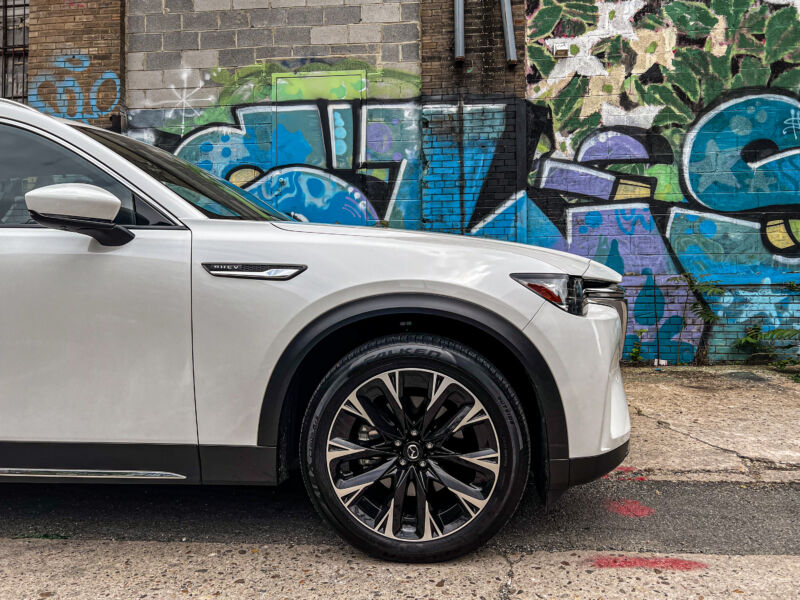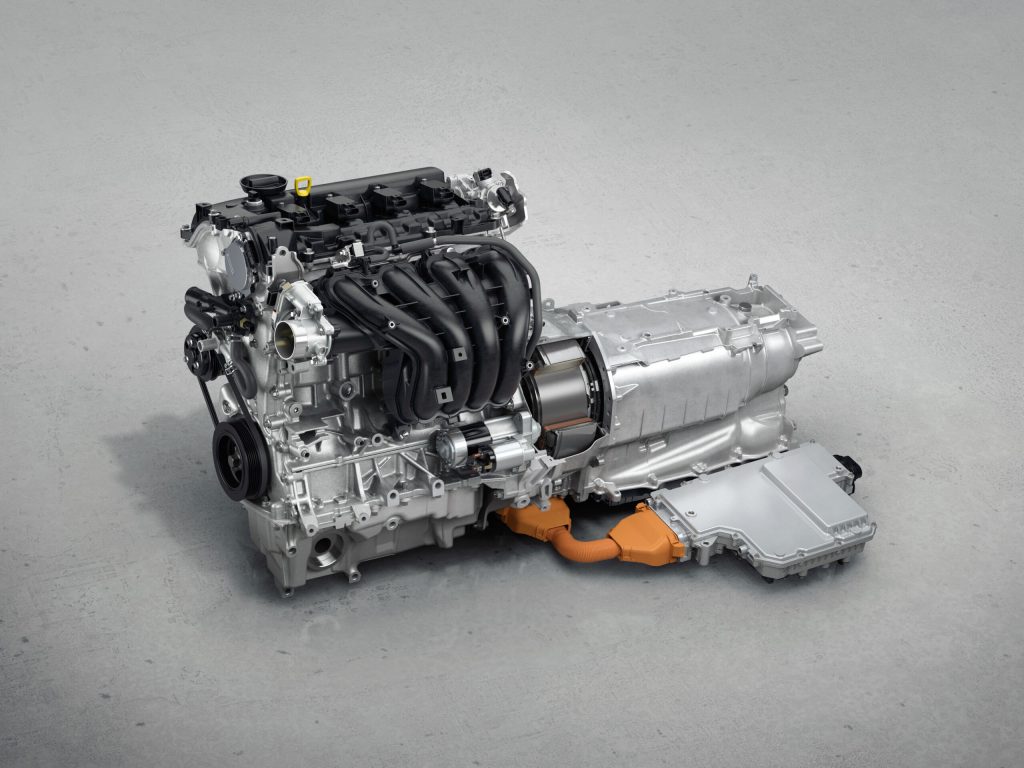This big Mazda is one of a handful of plug-in hybrid three-rows on sale today.

Fairly or not, the Mazda CX-90 PHEV had a lot to make up for. The last electrified Mazda we drove was the abysmal MX-30, a cynical compliance car that proved too unpopular to remain on sale. That was a small hatchback crossover with suicide doors and a cork interior. The CX-90 PHEV, Mazda’s full-size SUV, is a much more substantial proposition, with seating for up to eight and starting at a reasonable $47,445.
You may miss out on some of the very newest bells and whistles found in the latest German or Korean luxury cars, but as electrified three-rows go, there’s a fair bit to like about this one.
Tech specs
The CX-90 uses a newly developed Mazda platform for larger vehicles, with rear-biased all-wheel drive powertrains. There’s a turbocharged mild hybrid inline-six cylinder engine available in two different levels of tune, but the one we’re interested in is the e-Skyactiv G powertrain, which pairs a turbocharged four-cylinder engine generating 189 hp (141 kW) and 192 lb-ft (260 Nm) with a 173 hp (129 kW), 199 lb-ft (270 Nm) permanent magnet synchronous electric motor.
- If you need a gigantic SUV but also want it to be a PHEV, you don’t have too many choices. This one comes with a lot of good safety tech and not too much in the way of digital distraction, plus a great interior. Jonathan Gitlin
- With the third row of seats in use, there’s 14.9 cubic feet (423 L) of cargo volume. Drop the third row flat and that grows to 40 cubic feet (1,133 L). Fold down the middle row as well and you can fit 74.2 cubic feet (2,101 L) of stuff back there. Jonathan Gitlin
- A standard-size parking bay doesn’t leave much room. Jonathan Gitlin



Total combined output is 323 hp (240 kW) and 369 lb-ft (500 Nm), all of which goes to the wheels via an eight-speed planetary gear transmission that uses a wet clutch instead of a torque convertor. Mazda says there’s a North America-specific tune that, by the sounds of it, has a peppier torque curve for better acceleration than the versions sold in Europe or Asia.
ARS VIDEO
How The Callisto Protocol’s Team Designed Its Terrifying, Immersive Audio
There’s a 17.8 kWh lithium-ion battery pack with an EPA-rated electric-only range of up to 26 miles. Add a full tank of gas to that and the CX-90 PHEV should go 490 miles, according to the regulator. Charge times are about 2.5 hours with a 240 V level 2 charger, and there’s a charge button on the center console that will use spare power from the internal combustion engine to recharge the traction battery while you drive (with an attendant hit to fuel economy as you do).
In normal mode, as long as the battery has more than 20 percent state of charge, the car will default to using the electric motor alone for propulsion. In this combined gas-plus-electric mode, the EPA rates the CX-90 at 56 MPGe. Below 20 percent SoC, the engine stays on and maintains some charge in the battery, which Mazda says is so the EV assist is always available.
There’s also an EV mode, although if the throttle pedal passes the kick-down point, the ICE fires up again, and the car reverts to normal mode. Sport keeps the engine fired all the time and adds electric torque, but at 5,243 lbs, this is not an SUV that will ever feel sporty to drive.
- I don’t know about you, but my trips to Costco are not often long enough to get a meaningful charge in the battery. Particularly if there’s snow on the ground. Jonathan Gitlin
- In late spring, things went a lot better. Jonathan Gitlin
- Charging stats. Jonathan Gitlin
- The powertrain with a cutaway showing inside the electric motor, which is packaged between the engine and transmission. Mazda




Once the battery is fully depleted, fuel economy plummets as the relatively small engine works hard to keep this large SUV in motion—just 25 mpg (9.4 L/100 km) combined, according to the EPA.
What’s it like in the real world?
Actually reviewing this plug-in hybrid required more than one bite at the CX-90 PHEV cherry. Our first week with the SUV took place in January, with snow on the ground and temperatures well below freezing. PHEVs do not show their best in these conditions; even with a full charge, the engine will usually run to heat things that need heating, and driving a block was all it took to see the range drop by a mile.
Worse yet, our CX-90 was afflicted with heavier steering than anything this side of an IndyCar. That turned out to be a problem with the worm gear, and it was recall-worthy.
A second week in late spring went much better. This time, the power steering worked perfectly, and while it doesn’t have that same magic feedback you feel through the rim in a Mazda 3, CX-30, or MX-5 Miata, it is much more engaging than what you see in a CX-50. I’d go so far as to say it was pleasant to drive, with a good ride and predictable road manners. Still, it’s a large vehicle—202 inches (5,131 mm) long, 78 inches (1,981 mm wide), and 69 inches (1,753 mm) tall.
In temperate conditions, it was slightly more efficient than I expected from the EPA numbers. According to the trip computer, I was able to eke out 3.1 miles/kWh (20 kWh/100 km) when using the battery and 27.4 mpg (8.6 L/100 km) from the gasoline side of things.
The number of seats in the CX-90 depends upon which trim you choose. The entry-level Preferred is an eight-seater, with a pair of three-seat bench rows in the back. The $52,900 Premium and the $56,950 Premium Plus come as seven-seaters as standard, with a pair of captain’s chairs in the middle row instead. This layout is also available as an option for the base PHEV. (There is also a two-row version called Mazda CX-70, which is also available with this PHEV powertrain.)
Mazda is quite generous with standard equipment even in the Preferred trim, but our test car was the Premium Plus trim, which adds features like Nappa leather-trimmed seats, seat heaters for the middle row and the front seats (which are standard but now also gain ventilation), a deicer for the windshield wiper, 360-degree parking cameras, front cross-traffic braking and rear emergency braking, and a 12.3-inch infotainment system that offers wireless (rather than wired) Apple CarPlay and Android Auto.
Great interior
It’s a rather gorgeous cabin to sit in, with a good layout and plenty of discrete physical buttons to control the climate. The last few years have seen Mazda move its interior design upmarket, and the attention to detail shown here gives the CX-90 a cabin that compares well against SUVs that cost tens of thousands of dollars more.
- Mazda took better interior photos than I did, so I’m using them. This is a different trim from the black and silver of our test car. Mazda
- The main instrument display keeps information to a minimum. Jonathan Gitlin
- The top-trim CX-90 lets you use touch to interact with CarPlay and Android Auto, but you should stick to the dial on the center console. Jonathan Gitlin
- The 360-degree parking cameras are very helpful with such a large SUV. Jonathan Gitlin
- The view from the back. Mazda





Touchpoints like the armrests, seats, and the trim that covers the center console all feel made of quality materials. In a more expensive brand, the silver trim that our car featured (in place of the wood in Mazda’s images) would probably be textured; in the CX-90, it appears to have a crosshatch pattern to it, but this was just printed on.
The infotainment screen works as a touchscreen in CarPlay. But as many of us are realizing, touchscreens in cars are demonstrably worse than buttons, and the best way to interact with CarPlay, as well as Mazda’s stripped-down but functional native infotainment, is with the dial and buttons that live on the center console.
The upgraded parking sensors that come with the Premium Plus deserve a callout, too. For such a large SUV, it’s actually very easy to get into and out of tight parking spaces.
I give lower marks to the wireless phone charging pad. These are apparently the second-most requested in-car features among car buyers, but the CX-90’s did not like my iPhone’s case, and because there is no lip on the trailing edge of the wireless pad, any kind of vigorous acceleration would send my phone flying into the rear of the cabin.
Three-row PHEVs aren’t actually that common. There’s the significantly cheaper Mitsubishi Outlander PHEV, which is noticeable in the way it looks and feels. However, it can go further on a charge. Otherwise, the options are all parallel hybrids, unless you want to spend more than $70,000 on a Volvo XC90 T8. This Mazda is a good compromise, with a look and feel that’s almost as high-end as that Volvo but with a price tag much closer to the Mitsubishi.




